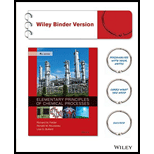
In an absorption tower (or absorber), a gas is contacted with a liquid under conditions such that one or more species in the gas dissolve in the liquid. A stripping tower (or stripper) also involves a gas contacting a liquid, but under conditions such that one or more components of the feed liquid come out of solution and exit in the gas leaving the tower.
A process consisting of an absorption tower and a stripping tower is used to separate the components of a gas containing 30.0 mole% carbon dioxide and the balance methane. A stream of this gas is fed to the bottom of the absorber. A liquid containing 0.500 mole% dissolved CO2 and the balance methanol is recycled from the bottom of the stripper and fed to the top of the absorber. The product gas leaving the top of the absorber contains 1.00 mole% CO2 and essentially all of the methane fed to the unit. The CO2-rich liquid solvent leaving the bottom of the absorber is fed to the top of the stripper and a stream of nitrogen gas is fed to the bottom. Ninety percent of the CO2 in the liquid feed to the stripper comes out of solution in the column, and the nitrogen/CO2 stream leaving the column passes out to the atmosphere through a stack. The liquid stream leaving the stripping tower is the 0.5(K)% CO2 solution recycled to the absorber.
The absorber operates at temperature Ta and pressure P, and the stripper operates at Tsand Ps. Methanol may be assumed to be nonvolatile—that is, none enters the vapor phase in either column— and N2 may be assumed insoluble in methanol.
- In your own words, explain the overall objective of this two-unit process and the functions of the absorber and stripper in the process.
For the stripper outlet gas, label the component molar flow rates rather than the total flow rate and mole fractions. Do the degree-of-freedom analysis and write in order the equations you would solve to determine all unknown stream variables except the nitrogen flow rate entering and leaving the stripper. Circle the variable(s) for w hich you would solve each equation (or set of simultaneous equations), but don't do any of the calculations yet.
I
' • J J
Want to see the full answer?
Check out a sample textbook solution
Chapter 4 Solutions
Elementary Principles of Chemical Processes, Binder Ready Version
Additional Engineering Textbook Solutions
Elements of Chemical Reaction Engineering (5th Edition) (Prentice Hall International Series in the Physical and Chemical Engineering Sciences)
Process Dynamics and Control, 4e
Concepts Of Programming Languages
Artificial Intelligence: A Modern Approach
Fundamentals of Applied Electromagnetics (7th Edition)
INTERNATIONAL EDITION---Engineering Mechanics: Statics, 14th edition (SI unit)
 Introduction to Chemical Engineering Thermodynami...Chemical EngineeringISBN:9781259696527Author:J.M. Smith Termodinamica en ingenieria quimica, Hendrick C Van Ness, Michael Abbott, Mark SwihartPublisher:McGraw-Hill Education
Introduction to Chemical Engineering Thermodynami...Chemical EngineeringISBN:9781259696527Author:J.M. Smith Termodinamica en ingenieria quimica, Hendrick C Van Ness, Michael Abbott, Mark SwihartPublisher:McGraw-Hill Education Elementary Principles of Chemical Processes, Bind...Chemical EngineeringISBN:9781118431221Author:Richard M. Felder, Ronald W. Rousseau, Lisa G. BullardPublisher:WILEY
Elementary Principles of Chemical Processes, Bind...Chemical EngineeringISBN:9781118431221Author:Richard M. Felder, Ronald W. Rousseau, Lisa G. BullardPublisher:WILEY Elements of Chemical Reaction Engineering (5th Ed...Chemical EngineeringISBN:9780133887518Author:H. Scott FoglerPublisher:Prentice Hall
Elements of Chemical Reaction Engineering (5th Ed...Chemical EngineeringISBN:9780133887518Author:H. Scott FoglerPublisher:Prentice Hall
 Industrial Plastics: Theory and ApplicationsChemical EngineeringISBN:9781285061238Author:Lokensgard, ErikPublisher:Delmar Cengage Learning
Industrial Plastics: Theory and ApplicationsChemical EngineeringISBN:9781285061238Author:Lokensgard, ErikPublisher:Delmar Cengage Learning Unit Operations of Chemical EngineeringChemical EngineeringISBN:9780072848236Author:Warren McCabe, Julian C. Smith, Peter HarriottPublisher:McGraw-Hill Companies, The
Unit Operations of Chemical EngineeringChemical EngineeringISBN:9780072848236Author:Warren McCabe, Julian C. Smith, Peter HarriottPublisher:McGraw-Hill Companies, The





